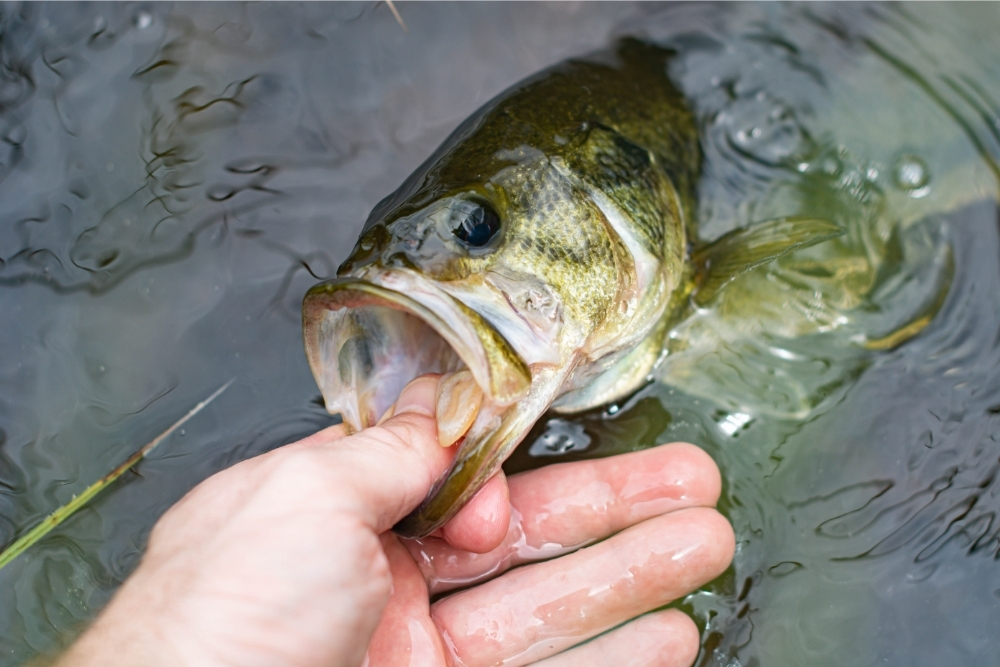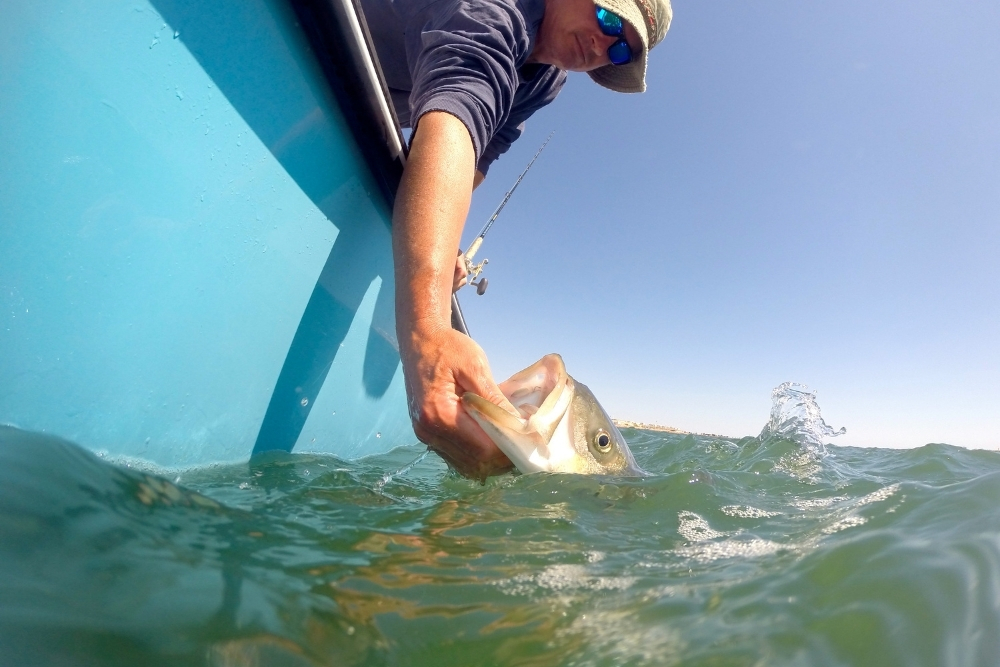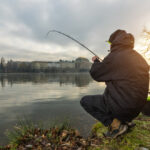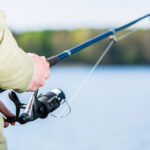Your patience has paid off, and you’ve finally managed to lure a bass onto your hook, now is the time to understand exactly how to hold a bass. Once you’ve won the fight of reeling the fish in, you need to bring it out of the water and hold it firmly in your grasp. This isn’t as easy as it seems, though. Bass are strong fish, and if you reel it in and hold it incorrectly, you can do some serious damage to yourself and the fish.
To help you make sure you’ve got full control of the bass when you’re extracting it from the water and when you’re holding it, we’ve put together some advice on how to hold a bass.
We’ll look at a couple of different ways of doing it safely and explain why knowing how to hold a bass correctly is so important.
By the time you’re done reading, you’ll be able to master this skill and pose for that commemorative photograph of your bass catch without putting yourself at risk.

Why Holding a Bass Matters
Most anglers take to the rivers, lakes, and seas with a strong catch-and-release ethos. This is a common practice in bass fishing and, once the angler has placed the bass back into the water, it is free to continue living, breeding, and hunting.
Fishing in this way requires proper handling of the fish as holding a bass, no matter how small, can create issues with the alignment of its jaws. As such, when the bass is returned to the water, it might run into difficulties hunting and feeding in the same way as it did before.
Sliding a bass out onto a rock, bank, or deck can also have a damaging effect on it. This is because the bass mucoprotein barrier, or “slime coat,” can be stripped away. This leaves them susceptible to coming into contact with life-threatening pathogens.
If you’re not used to handling a bass, these are scenarios that are all too easy to fall into. So you must learn how to properly hold a bass before you even attempt to fish for one.
Another thing that many anglers aren’t aware of, particularly those new to the sport, is that bass has razor-sharp teeth that can cause some real damage to your fingers. One quick nip and you risk dropping the bass, potentially causing it an injury or, in the worst-case scenario, killing it.
Before Holding Your Catch
One of the most important things to consider before holding your catch is whether it’s essential to be holding the bass in the first place.
Do you really need the trophy photograph? Or would you be just as happy safe in the knowledge that you managed to catch a big bass without feeling the need to capture the evidence in photo-form?
Aside from dislodging the hook, not every fish needs to be handled. That’s to say; you don’t need to take a photograph of yourself holding every bass you’ve ever caught.
Sure, if it’s a special occasion, such as your first bass catch, it’s something you’ll want to remember. But after that, the need to handle and photograph each catch isn’t really necessary.
On those occasions where you want to take a photograph with the bass, it’s important to think about how you’re going to lift it out of the water safely.
There are a couple of methods for doing this safely, and one of the most effective is to let the motion of the water bring the fish towards you.
You can also use a fish-grab tool to extract the fish from the water safely. This is a device that securely locks the bass bottom jaw and helps you lift it out of the water without causing any harm to the fish.
The most popular extraction method, however, is simply just to use a fishnet. This allows you to scoop the fish out of the water, and it’s gentle on the fish while being super-effective for you.
You also need to think about the amount of time you’re going to be holding the bass out of the water. If it’s left outside of its natural habitat for too long, it will become agitated, and, as a result, the chances of it jumping out of your grasp are increased.
The best way to stop this from happening is to hold it in the water using a keep net.
Holding a Bass Vertically
One of the most popular ways for holding a bass, and certainly one of the safest, is to hold it vertically using its weight. This means allowing it to hang vertically from your thumb and forefinger, keeping your grip firm but not too tight.
Holding the bass by its lower jaw when holding a bass vertically will prevent any injuries coming from its super-sharp teeth. Holding onto the lower jaw in this way also keeps your hands clear of the bass gill plate, so you’ll avoid causing damage to its respiratory system.
The bass tail will be hanging in a straight line directly beneath its mouth in this hold, allowing the weight of the bass to be evenly distributed throughout its body. This prevents excessive force or pressure from occurring in one area and keeps the jaw safe and protected.
Holding a Bass Horizontally
Larger bass is probably better suited to being held horizontally, as you’ll have more control over their weight. Not to mention, it makes for a more impressive photograph too!
Getting a grip on the bass in this way is similar to the vertical hold. Place your thumb inside the bass mouth to hold the lower lip firmly, then place your other hand gently on the underside of the body. This hand’s best placement is near the tail end, using only three or four fingers to support the bass weight.
It’s tempting to squeeze the bass in this hold, as you’ll want to feel as though you’ve got a super-secure grip on it. But don’t do this! Your lower hand is there to provide support only.
Holding a large bass horizontally stops the body from stretching, which may be an issue if you hold any large fish vertically. It also prevents the jaw from overextending, so the bass will be able to feed properly still once you’ve released it back into the water.
Different Hold for Different Sizes
The hold you choose will ultimately be determined by the size of the bass you’ve caught. The vertical hold is more suitable for smaller bass, as they will have a smaller weight and, as such, will be less susceptible to body-stretching and overextending the jaw.
If you’ve managed to catch yourself a real trophy bass, then the best way to hold it is in the horizontal position. This offers the fish the optimal amount of support for its body weight while reducing the risk of it flipping back and forth and injuring itself.
If you’re new to bass fishing, it’s a good idea to ask an experienced angler to show the correct way to hold a bass. Taking the time to learn how to hold a bass properly is an essential part of angling, and it ensures that the fish is safe while you hold it and once it’s been returned to the water.
Using a Fish Scale
You may also want to know how heavy the bass you’ve caught, especially if you’re competing or measuring your success with your different lures. It’s also a great way of showing off to your friends and getting those bragging rights!
However, as with holding the bass, you need to keep it safe while you weigh it. Learning to weigh a bass correctly will also give you an accurate reading.
The best way to weigh a bass is by using a sling scale calibrated to zero and holding the unit by its top loop. Gently place the bass in the sling once you’ve removed the line and hook, taking care not to damage the slime coat or scales as you do.
If the bass you’ve caught is behaving frantically and flapping around a bit, gently place your hands over its eyes while you watch it. This will help calm it down, especially if it’s been reeled out of muddy waters into bright sunlight.
Aside from this, you need to minimize how often you touch or hold the bass outside of the sling.
Returning a Bass to the Water

When you’re done photographing and weighing your catch, it’s time to return the bass to the water. Again, some care needs to be taken here. Don’t just throw it back in, as the impact of the water can cause injuries to the fish.
To return bass to the water correctly, gently slip your hand underneath its underbelly. Place one hand around the frontal fin and the other around its anal fin, then gently lower it back into the water. Once it’s fully submerged, you can release your grip.
Remember to loosen your grip when the fish is back in the water so that you’re supporting it rather than holding it, but don’t let go of it until it swims away.
It may take a few moments for the bass to recover from any shock it’s feeling and refamiliarize itself with the environment, so be patient and don’t let go of your supportive hold until it swims off by itself.
Final Thoughts on How to Hold A Bass
From reeling your bass in with the right bass fishing line, holding it, weighing it, and placing it back into the water, there are certain steps you need to take to ensure the bass is safe while in your care.
When it comes to holding and photographing your catch, we recommend using only one of the two holds detailed above. And, if it’s a particularly large bass, you should use a horizontal hold.
We’ll also reiterate that not every catch needs to be photographed. Simply admiring what you’ve managed to catch with your fishing skills is rewarding enough, and the less contact you have with the bass, the happier and healthier it will be when you release it back into the water.





